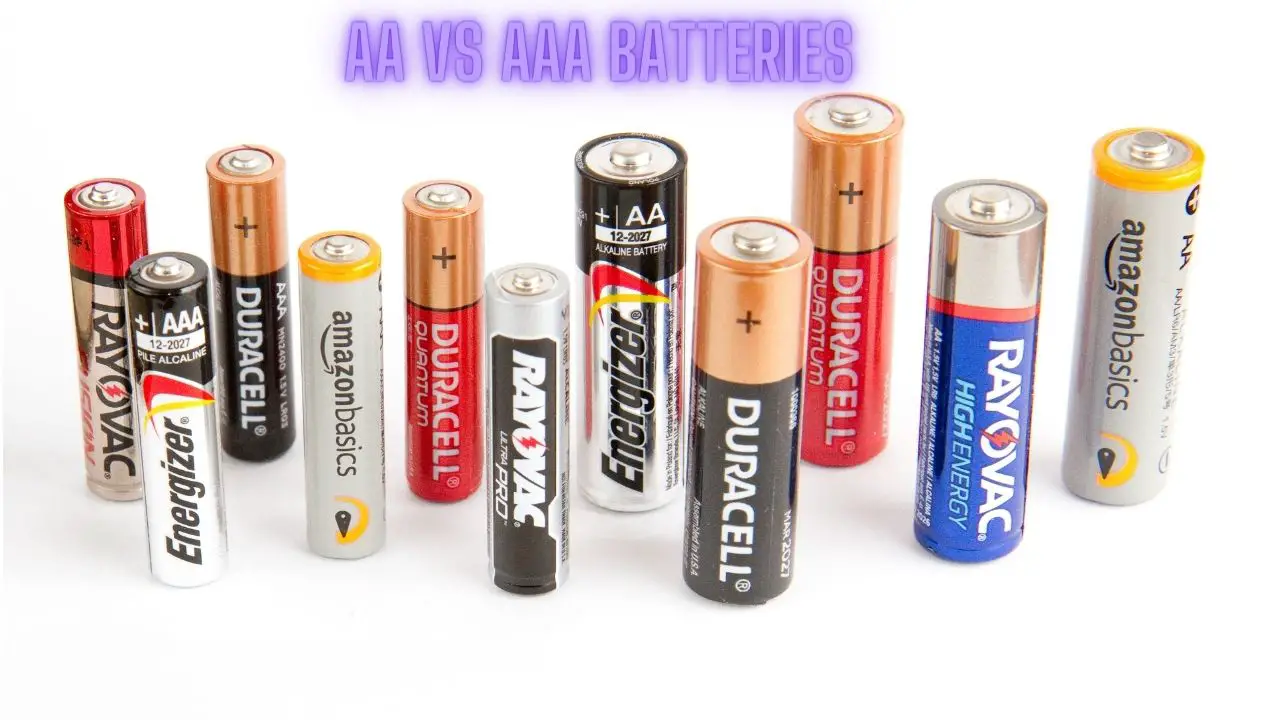AA Vs AAA Battery | Key Differences
Introduction
Batteries play a vital role in powering numerous electronic devices, from remote controls to flashlights, toys, and even some larger gadgets like cameras and portable speakers. Among the various battery sizes available, AA (double-A) and AAA (triple-A) batteries are two of the most commonly used types. Despite their similar names, AA and AAA batteries differ in size, capacity, and applications. This article provides an in-depth comparison of AA and AAA batteries, exploring their characteristics, advantages, limitations, and common applications to help consumers make informed choices when selecting batteries for their devices.
Overview of AA Batteries
AA batteries, also known as double-A batteries, are cylindrical dry cell batteries commonly used in a wide range of electronic devices. They are one of the most popular battery sizes due to their versatility, availability, and compatibility with numerous consumer electronics. Here’s an overview of AA batteries:
- Size and Dimensions:
- AA batteries are cylindrical in shape and measure approximately 14.5-14.9 mm in diameter and 49.2-50.5 mm in length, depending on the specific manufacturer and design. They are larger than AAA batteries but smaller than C and D batteries.
- Capacity and Voltage:
- AA batteries typically have a nominal voltage of 1.5 volts when new. They are available in both primary (non-rechargeable) and rechargeable formats. Alkaline AA batteries, which are the most common type, offer a capacity ranging from around 1,000 to 2,850 milliampere-hours (mAh), depending on the brand and quality. Rechargeable AA batteries, such as nickel-metal hydride (NiMH) and lithium-ion (Li-ion) variants, may offer similar or higher capacities.
- Chemistry:
- AA batteries are available in various chemistries, including alkaline, lithium, nickel-metal hydride (NiMH), and nickel-cadmium (NiCd). Alkaline AA batteries are the most widely used type and are suitable for a wide range of devices. Rechargeable NiMH AA batteries are also popular for their ability to be reused multiple times, making them more environmentally friendly than single-use alkaline batteries.
- Common Applications:
- AA batteries are used in a multitude of electronic devices, including but not limited to:
- Remote controls for TVs, DVD players, and other home entertainment devices.
- Flashlights and lanterns for illumination in emergency situations or outdoor activities.
- Digital cameras and camera flashes for capturing photos and videos.
- Portable audio devices such as radios, MP3 players, and portable speakers.
- Electronic toys, gaming controllers, and handheld gaming consoles.
- Clocks, wall clocks, and alarm clocks.
- Wireless computer peripherals such as keyboards and computer mice.
- AA batteries are used in a multitude of electronic devices, including but not limited to:
- Availability and Cost:
- AA batteries are widely available in retail stores, supermarkets, electronics stores, and online outlets. They are produced by numerous manufacturers and are often sold in multipacks to offer cost-effective purchasing options for consumers.
Overall, AA batteries are versatile, reliable, and widely compatible, making them an essential power source for a wide range of electronic devices in both household and professional settings.
Overview of AAA Batteries
AAA batteries, also known as triple-A batteries, are small cylindrical dry cell batteries commonly used in a variety of portable electronic devices. Despite their compact size, AAA batteries offer sufficient power to operate many everyday gadgets. Here’s an overview of AAA batteries:
- Size and Dimensions:
- AAA batteries are smaller than AA batteries but larger than AAAs. They typically have a diameter of approximately 10.5-10.7 mm and a length of about 44.5-44.9 mm. Their compact size makes them suitable for smaller electronic devices where space is limited.
- Capacity and Voltage:
- AAA batteries typically have a nominal voltage of 1.5 volts when new. Similar to AA batteries, they are available in both primary (non-rechargeable) and rechargeable formats. Alkaline AAA batteries, the most common type, offer a capacity ranging from around 600 to 1,200 milliampere-hours (mAh), depending on the brand and quality. Rechargeable AAA batteries, such as nickel-metal hydride (NiMH) variants, may offer similar or higher capacities.
- Chemistry:
- AAA batteries are available in various chemistries, including alkaline, lithium, nickel-metal hydride (NiMH), and nickel-cadmium (NiCd). Alkaline AAA batteries are widely used for general-purpose applications due to their affordability and availability. Rechargeable NiMH AAA batteries are popular for devices that require frequent battery replacement, offering the advantage of being reusable and environmentally friendly.
- Common Applications:
- AAA batteries power a wide range of portable electronic devices, including:
- Remote controls for TVs, stereos, and other home entertainment systems.
- Portable flashlights, LED lanterns, and headlamps for illumination in emergencies or outdoor activities.
- Digital cameras, camera flashes, and camera accessories.
- Wireless computer peripherals such as computer mice and keyboards.
- Electronic toys, remote-control cars, and handheld gaming devices.
- Personal audio devices such as MP3 players, portable radios, and audio recorders.
- Calculators, clocks, and small electronic gadgets.
- AAA batteries power a wide range of portable electronic devices, including:
- Availability and Cost:
- AAA batteries are widely available in retail stores, supermarkets, convenience stores, and online outlets. They are produced by multiple manufacturers and are often sold in multipacks to offer cost-effective purchasing options for consumers.
In summary, AAA batteries are compact, reliable, and versatile power sources for a wide range of portable electronic devices. Despite their small size, AAA batteries deliver sufficient energy to power various gadgets, making them indispensable in both household and professional settings.
Comparison of AA and AAA Batteries
- Size and Dimensions:
- AA batteries are larger and thicker than AAA batteries. AA batteries typically measure approximately 14.5-14.9 mm in diameter and 49.2-50.5 mm in length, while AAA batteries measure around 10.5-10.7 mm in diameter and 44.5-44.9 mm in length.
- Capacity and Voltage:
- AA batteries generally have a higher capacity than AAA batteries due to their larger size. While both AA and AAA batteries typically have a nominal voltage of 1.5 volts when new, AA batteries can hold more electrochemical material, resulting in higher energy storage capacity. Alkaline AA batteries typically offer capacities ranging from around 1,000 to 2,850 milliampere-hours (mAh), while alkaline AAA batteries typically offer capacities ranging from around 600 to 1,200 mAh.
- Common Applications:
- AA batteries are commonly used in larger electronic devices and those requiring higher power consumption. Examples include digital cameras, flashlights, portable radios, and electronic instruments. AAA batteries, on the other hand, are used in smaller electronic devices where space is limited. Common applications for AAA batteries include remote controls, small flashlights, wireless computer peripherals, and personal audio devices.
- Availability and Cost:
- Both AA and AAA batteries are widely available and produced by numerous manufacturers. They are commonly sold in multipacks in retail stores, supermarkets, and online outlets. In terms of cost, AA batteries may be slightly more expensive than AAA batteries due to their larger size and higher capacity.
- Compatibility and Versatility:
- While AA and AAA batteries are not interchangeable in terms of size, they are often compatible with the same types of electronic devices. Many devices are designed to accept either AA or AAA batteries, depending on the available space and power requirements. This versatility allows consumers to choose the appropriate battery size based on the specific needs of their devices.
- Environmental Impact:
- Rechargeable variants of both AA and AAA batteries are available, offering consumers a more environmentally friendly option compared to single-use disposable batteries. Rechargeable AA and AAA batteries, such as nickel-metal hydride (NiMH) and lithium-ion (Li-ion) variants, can be reused multiple times, reducing waste and resource consumption.
In summary, while AA and AAA batteries share similarities in terms of chemistry and function, they differ in size, capacity, and applications. AA batteries are larger and typically used in devices requiring higher power consumption, while AAA batteries are smaller and used in devices where space is limited. Both types of batteries are widely available, versatile, and compatible with a wide range of electronic devices.
Pros and Cons of AA Batteries
Pros of AA Batteries:
- High Capacity: AA batteries typically have a higher capacity compared to smaller battery sizes like AAA or coin cells. This means they can provide more power and longer runtime in electronic devices.
- Versatility: AA batteries are compatible with a wide range of electronic devices, including remote controls, flashlights, digital cameras, portable radios, and electronic toys. Their versatility makes them a convenient choice for many applications.
- Widespread Availability: AA batteries are widely available in retail stores, supermarkets, convenience stores, and online outlets. They are produced by numerous manufacturers and are commonly sold in multipacks, making them easily accessible to consumers.
- Cost-Effective: Due to their popularity and widespread availability, AA batteries are often more cost-effective compared to less common battery sizes. Buying AA batteries in bulk or multipacks can further reduce the cost per battery.
- Rechargeable Options: Rechargeable AA batteries, such as nickel-metal hydride (NiMH) and lithium-ion (Li-ion) variants, are available for those who prefer a more sustainable and environmentally friendly power source. Rechargeable AA batteries can be reused multiple times, reducing waste and saving money in the long run.
Cons of AA Batteries:
- Size and Weight: AA batteries are larger and heavier compared to smaller battery sizes like AAA or coin cells. This can be a disadvantage in devices where space and weight are critical factors, such as compact electronics or wearable devices.
- Limited Compatibility: Some smaller electronic devices may be designed to accommodate smaller battery sizes like AAA or coin cells, making AA batteries incompatible with these devices. In such cases, users may need adapters or alternative power sources.
- Single-Use Variants: While rechargeable options are available, many AA batteries are single-use disposable batteries. This can contribute to environmental pollution and waste if not disposed of properly or recycled.
- Voltage Drop: As with all batteries, AA batteries experience a gradual decrease in voltage as they discharge. This voltage drop can affect the performance of electronic devices, particularly those sensitive to fluctuations in power supply.
- Storage Considerations: Storing unused AA batteries for extended periods can lead to self-discharge and loss of capacity over time. Proper storage conditions, such as cool and dry environments, can help preserve the performance of AA batteries when not in use.
Pros and Cons of AAA Batteries
Pros of AAA Batteries:
- Compact Size: AAA batteries are smaller and more compact compared to larger battery sizes like AA or C batteries. This makes them ideal for electronic devices where space is limited or weight is a concern.
- Lightweight: Due to their smaller size, AAA batteries are lightweight, making them suitable for portable electronic devices and gadgets that require a lightweight power source.
- Versatility: AAA batteries are compatible with a wide range of electronic devices, including remote controls, small flashlights, wireless computer peripherals, personal audio devices, and electronic toys. Their versatility makes them a popular choice for many consumer electronics.
- Widespread Availability: AAA batteries are widely available in retail stores, supermarkets, convenience stores, and online outlets. They are produced by numerous manufacturers and are commonly sold in multipacks, making them easily accessible to consumers.
- Cost-Effective: AAA batteries are often more cost-effective compared to larger battery sizes like AA or C batteries. Buying AAA batteries in bulk or multipacks can further reduce the cost per battery.
Cons of AAA Batteries:
- Lower Capacity: AAA batteries generally have a lower capacity compared to larger battery sizes like AA or C batteries. This means they provide less power and shorter runtime in electronic devices, particularly those with higher power consumption.
- Limited Power Output: Due to their smaller size and lower capacity, AAA batteries may not be suitable for high-power electronic devices or applications that require a significant amount of energy.
- Single-Use Variants: While rechargeable options are available, many AAA batteries are single-use disposable batteries. This can contribute to environmental pollution and waste if not disposed of properly or recycled.
- Voltage Drop: Like all batteries, AAA batteries experience a gradual decrease in voltage as they discharge. This voltage drop can affect the performance of electronic devices, particularly those sensitive to fluctuations in power supply.
- Storage Considerations: Storing unused AAA batteries for extended periods can lead to self-discharge and loss of capacity over time. Proper storage conditions, such as cool and dry environments, can help preserve the performance of AAA batteries when not in use.
Choosing Between AA and AAA Batteries
Choosing between AA and AAA batteries depends on several factors, including the specific requirements of your electronic devices, available space, power consumption, and personal preferences. Here are some considerations to help you make the right choice:
- Device Compatibility: Check the battery compartment of your electronic device to determine which battery size it requires. Some devices may be designed to accommodate either AA or AAA batteries, while others may only accept one specific size. Choose the battery size that is compatible with your device.
- Power Requirements: Consider the power consumption of your electronic device. AA batteries typically have a higher capacity than AAA batteries and can provide longer runtime in devices with higher power consumption. If your device requires more power or operates for extended periods, AA batteries may be a better choice.
- Space Constraints: Evaluate the available space in the battery compartment of your device. If space is limited or if the device is compact, AAA batteries may be a more suitable option due to their smaller size. AAA batteries are often used in smaller electronic devices where space is a concern.
- Weight Considerations: If weight is a critical factor, such as in portable or handheld devices, consider the weight difference between AA and AAA batteries. AAA batteries are smaller and lighter than AA batteries, making them preferable for devices where weight savings are important.
- Cost and Availability: Compare the cost and availability of AA and AAA batteries. While both sizes are widely available and relatively affordable, AA batteries may be slightly more expensive due to their larger size and higher capacity. Consider purchasing batteries in bulk or multipacks to save money in the long run.
- Rechargeable Options: Determine if you prefer disposable or rechargeable batteries. Both AA and AAA batteries are available in rechargeable variants, offering a more sustainable and environmentally friendly option compared to single-use disposable batteries. Rechargeable batteries can be reused multiple times, reducing waste and saving money over time.
- Personal Preference: Ultimately, your choice between AA and AAA batteries may come down to personal preference. Consider factors such as convenience, ease of handling, and any past experiences with using either battery size.
By considering these factors and assessing your specific needs, you can choose the battery size that best suits your electronic devices and preferences. Whether you opt for AA or AAA batteries, ensure you select high-quality batteries from reputable brands to ensure optimal performance and reliability.
Usage Tips and Best Practices for AA and AAA Batteries:
- Store Batteries Properly: Store batteries in a cool, dry place at room temperature. Avoid storing them in extreme temperatures or humid environments, as this can reduce their performance and lifespan.
- Check Expiry Dates: Always check the expiry dates or best-by dates on battery packaging before purchasing. Using expired batteries can result in reduced performance or leakage.
- Use Fresh Batteries: Whenever possible, use fresh batteries for optimal performance. Older batteries may have reduced capacity and may not provide sufficient power to electronic devices.
- Avoid Mixing Batteries: Avoid mixing different battery types, brands, or capacities in the same device. Mixing batteries can lead to uneven discharge rates, which may affect device performance or cause damage.
- Remove Batteries When Not in Use: Remove batteries from electronic devices when they are not in use for extended periods. This helps prevent corrosion and leakage, which can damage the device.
- Dispose of Batteries Properly: Dispose of used batteries properly according to local regulations. Many communities have battery recycling programs or drop-off locations where you can safely dispose of batteries.
- Use Rechargeable Batteries: Consider using rechargeable batteries, such as nickel-metal hydride (NiMH) or lithium-ion (Li-ion) batteries, for devices with frequent battery replacement needs. Rechargeable batteries are more environmentally friendly and cost-effective in the long run.
- Charge Rechargeable Batteries Fully: When charging rechargeable batteries, ensure they are fully charged before use. Partially charged batteries may not provide optimal performance and may require more frequent recharging.
- Follow Manufacturer’s Instructions: Follow the manufacturer’s instructions and guidelines for battery usage, charging, and disposal. Different battery types and brands may have specific recommendations for optimal performance and safety.
- Monitor Battery Performance: Regularly monitor the performance of batteries in electronic devices. If you notice any signs of reduced performance, such as shorter runtime or decreased power output, replace the batteries promptly.
By following these usage tips and best practices, you can maximize the performance, lifespan, and safety of AA and AAA batteries in your electronic devices.
AA Vs AAA Battery FAQs
- What is the difference between AA and AAA batteries?
- AA batteries are larger and have higher capacity compared to AAA batteries, which are smaller and more compact.
- Which devices use AA batteries?
- AA batteries are commonly used in larger electronic devices such as digital cameras, flashlights, portable radios, and electronic toys.
- Which devices use AAA batteries?
- AAA batteries are commonly used in smaller electronic devices such as remote controls, small flashlights, wireless computer peripherals, and personal audio devices.
- Can AA batteries be used in place of AAA batteries?
- No, AA batteries cannot be used in place of AAA batteries and vice versa. They have different sizes and are not interchangeable.
- Which battery size is more cost-effective?
- The cost-effectiveness of AA and AAA batteries depends on factors such as brand, type (rechargeable or disposable), and quantity purchased. In general, AAA batteries may be slightly cheaper due to their smaller size.
- Are rechargeable AA and AAA batteries available?
- Yes, both AA and AAA batteries are available in rechargeable variants, such as nickel-metal hydride (NiMH) or lithium-ion (Li-ion) batteries.
- What are the advantages of rechargeable batteries?
- Rechargeable batteries are more environmentally friendly and cost-effective in the long run, as they can be reused multiple times.
- How long do AA and AAA batteries last?
- The lifespan of AA and AAA batteries varies depending on factors such as brand, capacity, and usage patterns. Alkaline disposable batteries typically last longer than rechargeable batteries in terms of single-use capacity.
- Can I mix different battery sizes in the same device?
- It is not recommended to mix different battery sizes in the same device, as this can lead to uneven discharge rates and potentially damage the device.
- How should I dispose of used batteries?
- Used batteries should be disposed of properly according to local regulations. Many communities have battery recycling programs or drop-off locations where you can safely dispose of batteries.
These FAQs provide basic information about AA and AAA batteries, their uses, advantages, and disposal methods. If you have further questions or concerns about battery usage, consult the manufacturer’s instructions or seek advice from a qualified professional.
Conclusion
In conclusion, AA and AAA batteries are essential power sources for a wide range of electronic devices, offering versatility, convenience, and reliability. While AA batteries are larger and provide higher capacity, AAA batteries are smaller and more compact, making them suitable for devices with limited space. Both battery sizes have their advantages and disadvantages, and the choice between them depends on factors such as device compatibility, power requirements, and personal preferences.
By following usage tips and best practices such as proper storage, avoiding mixing batteries, and using rechargeable options when feasible, you can ensure optimal performance and longevity of AA and AAA batteries in your electronic devices. Whether you opt for single-use disposable batteries or rechargeable variants, selecting high-quality batteries from reputable brands is essential to maximize performance and reliability.
Ultimately, AA and AAA batteries play a crucial role in powering various electronic devices, from remote controls and flashlights to digital cameras and portable audio players. By understanding their characteristics, advantages, and limitations, you can make informed decisions when choosing the right battery size for your specific needs.







